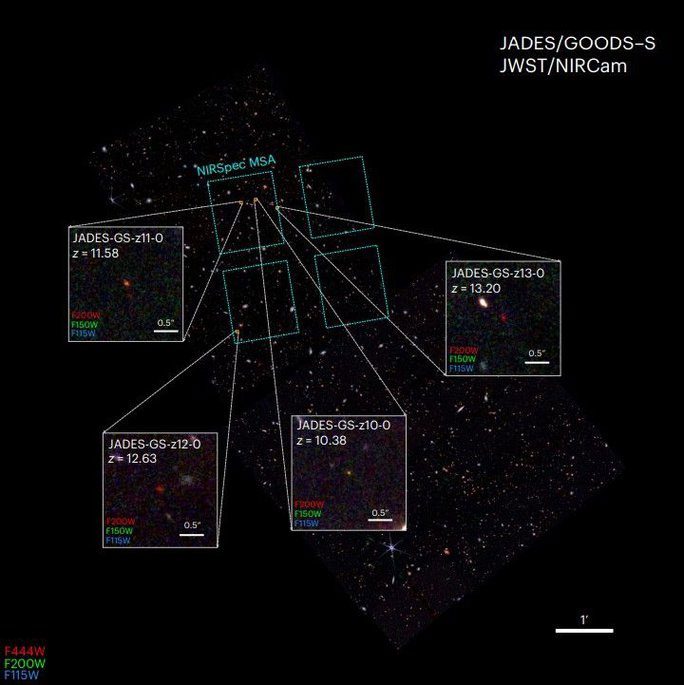The advanced James Webb Space Telescope has set a new record by identifying the four oldest galaxies known in the universe, formed just 300 million years after the Big Bang.
The new data has truly allowed scientists to peer directly into the past, as the light from these galaxies, located 13.5 billion light-years away, not only has to traverse that distance but also takes 13.5 billion years to reach us.
In other words, these are strong images from 13.5 billion years ago, literally transcending time, providing a real glimpse into the cosmic dawn.

Images transmitted to Earth from 13.5 billion years ago revealing four ancient galaxies – (Photo: NATURE).
The new study was conducted by an international team of scientists from the UK, Italy, the Netherlands, the USA, Germany, and Australia, led by Dr. Emma Curtis-Lake from the Astronomy Centre at the University of Hertfordshire (UK) and Dr. Stefano Carniani from the Scuola Normale Superiore di Pisa (Italy).
According to Live Science, unlike some previous studies that suggested what might be “potential galaxies” of a similar age, also based on James Webb data, this new research confirms that they are indeed ancient galaxies and not possible impostors.
Furthermore, they were able to analyze signs of the operational dynamics of these galaxies. They existed during the “reionization period,” when the first stars were formed.
The publication in Nature states that after confirming the age of the galaxies, the researchers measured the sizes of the stars and found them to be smaller than those in the current Milky Way galaxy that contains Earth.
What is surprising is that the star formation process was vigorous, at a rate that they did not expect in such a primordial world.
These galaxies also seemingly do not contain any particularly complex elements, indicating that their stars had not yet had time to create heavier elements and were composed only of hydrogen and helium from the early universe.
This aligns with theories and models about the early universe having a simple chemical composition.
The vigorous star formation also suggests that these galaxies grew very quickly, meaning that the early universe had a more vibrant start than we might imagine.
These ancient galaxies and their stars can be regarded as the “ancestors” of everything that exists today, including our Milky Way and our small planet Earth.
The simple stars in these primordial galaxies also had poor compositions and typically had short lifespans, but their existence—comprising fusion reactions in their cores, what happens when they die and explode into supernovae—was sufficient to fulfill the mission of a “factory” synthesizing heavier elements.
Accordingly, the deaths of these stars—and possibly all four galaxies have long since perished—provided richer materials for the next generation of galaxies and stars.
This continuous process over multiple generations has created a universe with the rich chemical composition we see today, much like how humanity diversifies its genes and evolves to new levels.
James Webb is currently the most advanced telescope in the world, primarily developed and operated by NASA, with contributions from ESA and CSA (the European and Canadian space agencies). Its main mission is to look into the cosmic dawn to search for ancient objects.





















































